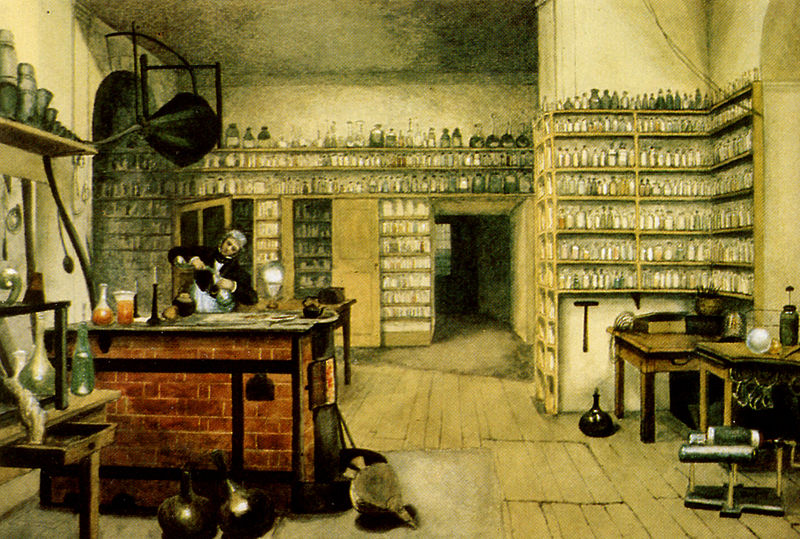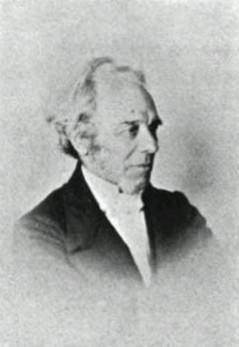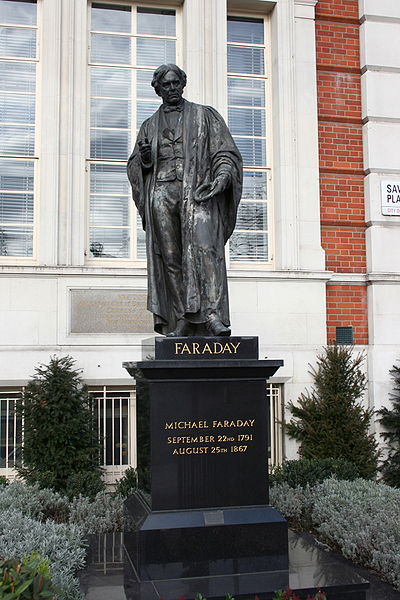<Back to Index>
- Chemist and Physicist Michael Faraday, 1791
- Architect Erik Gunnar Asplund, 1885
- Emperor of Vietnam Tự Đức, 317
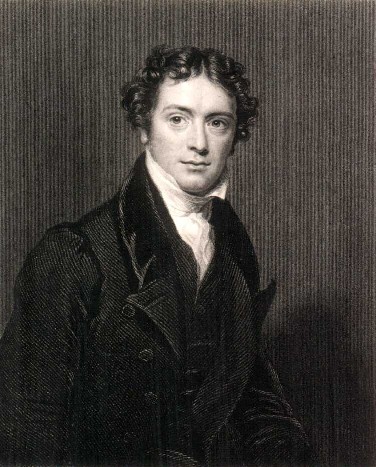
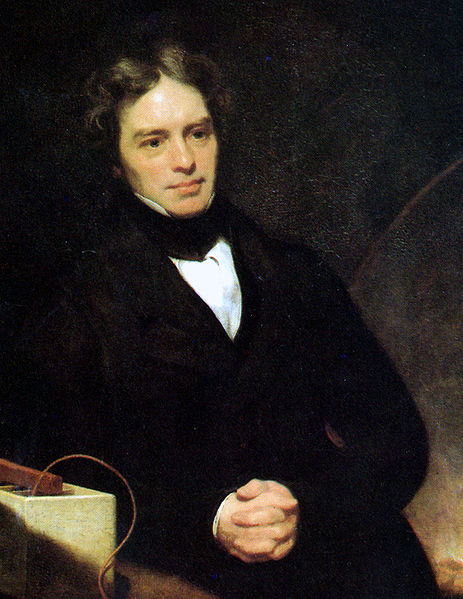
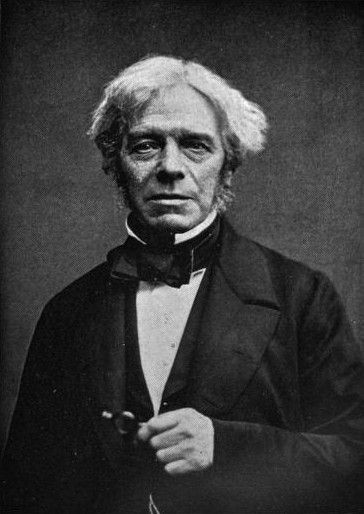
Michael Faraday, FRS (22 September 1791 – 25 August 1867) was an English chemist and physicist (or natural philosopher, in the terminology of the time) who contributed to the fields of electromagnetism and electrochemistry.
Faraday studied the magnetic field around a conductor carrying a DC electric current, and established the basis for the electromagnetic field concept in physics. He discovered electromagnetic induction, diamagnetism, and laws of electrolysis. He established that magnetism could affect rays of light and that there was an underlying relationship between the two phenomena. His inventions of electromagnetic rotary devices formed the foundation of electric motor technology, and it was largely due to his efforts that electricity became viable for use in technology. As a chemist, Michael Faraday discovered benzene, investigated the clathrate hydrate of chlorine, invented an early form of the Bunsen burner and the system of oxidation numbers, and popularized terminology such as anode, cathode, electrode, and ion. Although
Faraday received little formal education and knew little of higher
mathematics, such as calculus, he was one of the most influential scientists in history. Some historians of science refer to him as the best experimentalist in the history of science. The SI unit of capacitance, the farad, is named after him, as is the Faraday constant, the charge on a mole of electrons (about 96,485 coulombs). Faraday's law of induction states that a magnetic field changing in time creates a proportional electromotive force. Faraday was the first and foremost Fullerian Professor of Chemistry at the Royal Institution of Great Britain, a position to which he was appointed for life. Albert Einstein kept a photograph of Faraday on his study wall alongside pictures of Isaac Newton and James Clerk Maxwell. Faraday was highly religious; he was a member of the Sandemanian Church, a Christian sect
founded in 1730 that demanded total faith and commitment. Biographers
have noted that "a strong sense of the unity of God and nature pervaded
Faraday's life and work." Faraday was born in Newington Butts, now part of the London Borough of Southwark; but then a suburban part of Surrey, one mile south of London Bridge. His family was not well off. His father, James, was a member of the Glassite sect of Christianity. James Faraday moved his wife and two children to London during the winter of 1790-1 from Outhgill in Westmorland, where he had been an apprentice to the village blacksmith. Michael
was born the autumn of that year. The young Michael Faraday, the third
of four children, having only the most basic of school educations, had
to largely educate himself. At fourteen he became apprenticed to a local bookbinder and bookseller George Riebau and, during his seven-year apprenticeship, he read many books, including Isaac Watts' The Improvement of the Mind,
and he enthusiastically implemented the principles and suggestions that
it contained. He developed an interest in science, especially in
electricity. In particular, he was inspired by the book Conversations in Chemistry by Jane Marcet. At the age of twenty, in 1812, at the end of his apprenticeship, Faraday attended lectures by the eminent English chemist Humphry Davy of the Royal Institution and Royal Society, and John Tatum, founder of the City Philosophical Society. Many tickets for these lectures were given to Faraday by William Dance (one of the founders of the Royal Philharmonic Society).
Afterwards, Faraday sent Davy a three hundred page book based on notes
taken during the lectures. Davy's reply was immediate, kind, and
favourable. When Davy damaged his eyesight in an accident with nitrogen trichloride,
he decided to employ Faraday as a secretary. When John Payne, one of
the Royal Institution's assistants, was sacked, Sir Humphry Davy was
asked to find a replacement. He appointed Faraday as Chemical Assistant
at the Royal Institution on 1 March 1813. In
the class-based English society of the time, Faraday was not considered
a gentleman. When Davy went on a long tour to the continent in 1813–15,
his valet did
not wish to go. Faraday was going as Davy's scientific assistant, and
was asked to act as Davy's valet until a replacement could be found in
Paris. Faraday was forced to fill the role of valet as well as
assistant throughout the trip. Davy's wife, Jane Apreece, refused to treat Faraday as an equal (making him travel outside the
coach, eat with the servants, etc.) and generally made Faraday so
miserable that he contemplated returning to England alone and giving up
science altogether. The trip did, however, give him access to the
European scientific elite and a host of stimulating ideas. Faraday was a devout Christian. His Sandemanian denomination was an offshoot of the Church of Scotland. Well after his marriage, he served as Deacon and two terms as an Elder in the meeting house of his youth. His church was located at Paul's Alley in the Barbican. This meeting house relocated in 1862 to Barnsbury Grove, Islington.
This North London location is where Faraday served the final two years
of his second term as Elder prior to his resignation from that post. Faraday married Sarah Barnard (1800–1879) on 12 June 1821, although they would never have children. They
met through their families at the Sandemanian church. He confessed his
faith to the Sandemanian congregation the month after he married. Faraday's earliest chemical work was as an assistant to Humphry Davy. Faraday made a special study of chlorine, and discovered two new chlorides of carbon. He also made the first rough experiments on the diffusion of gases, a phenomenon first pointed out by John Dalton, the physical importance of which was more fully brought to light by Thomas Graham and Joseph Loschmidt.
He succeeded in liquefying several gases; he investigated the alloys of
steel, and produced several new kinds of glass intended for optical
purposes. A specimen of one of these heavy glasses afterwards became
historically important as the substance in which Faraday detected the
rotation of the plane of polarisation of light when the glass was
placed in a magnetic field, and also as the substance that was first
repelled by the poles of the magnet. He also endeavoured, with some
success, to make the general methods of chemistry, as distinguished
from its results, the subject of special study and of popular
exposition. He invented an early form of what was to become the Bunsen burner, which is used almost universally in science laboratories as a convenient source of heat. Faraday
worked extensively in the field of chemistry, discovering chemical
substances such as benzene (which he called bicarburet of hydrogen),
and liquefying gases such as chlorine. Liquification of gases helped
establish that gases are but the vapours of liquids possessing a very
low boiling-point, and gave a more sure basis to our views of molecular
aggregation. In 1820 Faraday reported on the first syntheses of
compounds made from carbon and chlorine, C2Cl6 and C2Cl4, and published his results the following year. Faraday also determined the composition of the chlorine clathrate hydrate, which had been discovered by Humphry Davy in 1810. Faraday
also discovered the laws of electrolysis and popularised terminology
such as anode, cathode, electrode, and ion, terms largely created by William Whewell. Faraday was the first to report what later came to be called metallic nanoparticles. In 1847 he discovered that the optical properties of gold colloids differed from those of the corresponding bulk metal. This was probably the first reported observation of the effects of quantum size, and might be considered to be the birth of nanoscience. Two years after the death of Davy, in 1831, he began his great series of experiments in which he discovered electromagnetic induction. Joseph Henry likely discovered self-induction a few months earlier and both may have been anticipated by the work of Francesco Zantedeschi in Italy in 1829 and 1830. Faraday's
breakthrough came when he wrapped two insulated coils of wire around an
iron ring, and found that, upon passing a current through one coil, a
momentary current was induced in the other coil. This phenomenon is known as mutual induction.
The iron ring-coil apparatus is still on display at the Royal
Institution. In subsequent experiments, he found that, if he moved a
magnet through a loop of wire, an electric current flowed in the wire.
The current also flowed if the loop was moved over a stationary magnet.
His demonstrations established that a changing magnetic field produces
an electric field. This relation was modelled mathematically by James Clerk Maxwell as Faraday's law, which subsequently became one of the four Maxwell equations. These in turn have evolved into the generalisation known today as field theory. Faraday later used the principle to construct the electric dynamo, the ancestor of modern power generators. In 1839, he completed a series of experiments aimed at investigating the fundamental nature of electricity. Faraday used "static", batteries, and "animal electricity" to produce the phenomena of electrostatic attraction, electrolysis, magnetism,
etc. He concluded that, contrary to scientific opinion of the time, the
divisions between the various "kinds" of electricity were illusory.
Faraday instead proposed that only a single "electricity" exists, and
the changing values of quantity and intensity (current and voltage)
would produce different groups of phenomena. Near
the end of his career, Faraday proposed that electromagnetic forces
extended into the empty space around the conductor. This idea was
rejected by his fellow scientists, and Faraday did not live to see this
idea eventually accepted. Faraday's concept of lines of flux emanating
from charged bodies and magnets provided a way to visualise electric
and magnetic fields. That mental model was crucial to the successful
development of electromechanical devices that dominated engineering and
industry for the remainder of the 19th century. In 1845, Faraday discovered that many materials exhibit a weak repulsion from a magnetic field, a phenomenon he named diamagnetism. Faraday also found that the plane of polarisation of
linearly polarised light can be rotated by the application of an
external magnetic field aligned in the direction the light is moving.
This is now termed the Faraday effect. He wrote in his notebook, "I have at last succeeded in illuminating a magnetic curve or line of force and in magnetising a ray of light". Late
in life (1862), Faraday used a spectroscope to search for a different
alteration of light, the change of spectral lines by an applied
magnetic field. However, the equipment available to him was
insufficient for a definite determination of a spectral change. Pieter Zeeman later
used an improved apparatus to study the same phenomenon, publishing his
results in 1897 and receiving the 1902 Nobel Prize in Physics for his
success. In both his 1897 paper and his Nobel acceptance speech, Zeeman referred to Faraday's work. In
his work on static electricity, Faraday demonstrated that the charge
resided only on the exterior of a charged conductor, and exterior
charge had no influence on anything enclosed within a conductor. This
is because the exterior charges redistribute such that the interior
fields due to them cancel. This shielding effect is used in what is now
known as a Faraday cage. Faraday
was an excellent experimentalist who conveyed his ideas in clear and
simple language. However, his mathematical abilities did not extend as
far as trigonometry or any but the simplest algebra. It was James Clerk Maxwell who
took the work of Faraday, and others, and consolidated it with a set of
equations that lie at the base of all modern theories of
electromagnetic phenomena. On Faraday's uses of the lines of force,
Maxwell wrote that they show Faraday "to have been in reality a
mathematician of a very high order — one from whom the mathematicians of the future may derive valuable and fertile methods." Faraday was the first Fullerian Professor of Chemistry at the Royal Institution of Great Britain, a position to which he was appointed for life. His sponsor and mentor was John 'Mad Jack' Fuller, who created the position at the Royal Institution. Faraday was elected a member of the Royal Society in 1824, appointed
director of the laboratory in 1825; and in 1833 he was appointed
Fullerian Professor of Chemistry in the institution for life, without
the obligation to deliver lectures. Beyond
his scientific research into areas such as chemistry, electricity, and
magnetism at the Royal Institution, Faraday undertook numerous, and
often time-consuming, service projects for private enterprise and the
British government. This work included investigations of explosions in
coal mines, being an expert witness in court, and the preparation of high-quality optical glass. In 1846, together with Charles Lyell, he produced a lengthy and detailed report on a serious explosion in the colliery at Haswell County Durham, which killed 95 miners. Their report was a meticulous forensic investigation and indicated that coal dust contributed
to the severity of the explosion. The report should have warned coal
owners of the hazard of coal dust explosions, but the risk was ignored
for over 60 years until the Senghenydd Colliery Disaster of 1913. As
a respected scientist in a nation with strong maritime interests,
Faraday spent extensive amounts of time on projects such as the
construction and operation of light houses and protecting the bottoms of ships from corrosion. Faraday also was active in what would now be called environmental science, or engineering. He investigated industrial pollution at Swansea and was consulted on air pollution at the Royal Mint. In July 1855, Faraday wrote a letter to The Times on the subject of the foul condition of the River Thames, which resulted in an oft-reprinted cartoon in Punch. Faraday assisted with planning and judging of exhibits for the Great Exhibition of 1851 in London. He also advised the National Gallery on the cleaning and protection of its art collection, and served on the National Gallery Site Commission in 1857. Education
was another area of service for Faraday. He lectured on the topic in
1854 at the Royal Institution, and in 1862 he appeared before a Public
Schools Commission to give his views on education in Great Britain.
Faraday also weighed in, negatively, on the public's fascination with
table-turning, mesmerism, and seances, chastising both the public and
the nation's educational system. Faraday gave a successful series of lectures on the chemistry and physics of flames at the Royal Institution, entitled The Chemical History of a Candle. This was one of the earliest Christmas lectures for
young people, which are still given each year. Between 1827 and 1860,
Faraday gave the Christmas lectures a record nineteen times. In June 1832, the University of Oxford granted Faraday a Doctor of Civil Law degree (honorary). During his lifetime, Faraday rejected a knighthood and twice refused to become President of the Royal Society. Faraday was elected a foreign member of the Royal Swedish Academy of Sciences in 1838, and was one of eight foreign members elected to the French Academy of Sciences in 1844. In 1848, as a result of representations by the Prince Consort, Michael Faraday was awarded a grace and favour house in Hampton Court, Surrey free
of all expenses or upkeep. This was the Master Mason's House, later
called Faraday House, and now No. 37 Hampton Court Road. In 1858 Faraday retired to live there. When asked by the British government to advise on the production of chemical weapons for use in the Crimean War (1853–1856), Faraday refused to participate citing ethical reasons. Faraday died at his house at Hampton Court on 25 August 1867. He had previously turned down burial in Westminster Abbey, but he has a memorial plaque there, near Isaac Newton's tomb. Faraday was interred in the dissenters' (non-Anglican) section of Highgate Cemetery.
Faraday
is best known for his work with electricity and magnetism. The first
experiment that he recorded was the construction of a voltaic pile with
seven halfpence pieces, stacked together with seven disks of sheet
zinc, and six pieces of paper moistened with salt water. With this pile
he decomposed sulphate of magnesia. In 1821, soon after the Danish physicist and chemist, Hans Christian Ørsted discovered the phenomenon of electromagnetism, Davy and British scientist William Hyde Wollaston tried but failed to design an electric motor. Faraday,
having discussed the problem with the two men, went on to build two
devices to produce what he called electromagnetic rotation: a
continuous circular motion from the circular magnetic force around a
wire and a wire extending into a pool of mercury with
a magnet placed inside would rotate around the magnet if supplied with
current from a chemical battery. The latter device is known as a homopolar motor.
These experiments and inventions form the foundation of modern
electromagnetic technology. In his excitement, Faraday published
results without acknowledging his work with either Wollaston or Davy.
The resulting controversy within the Royal Society strained
his mentor relationship with Davy and may well have contributed to
Faraday’s assignment to other activities, thereby removing him from
electromagnetic research for several years. From
his initial electromagnetic (EM) discovery in 1821, Faraday continued
his laboratory work exploring properties of materials and developing
the requisite experience. In 1824, Faraday briefly set up a circuit to
study whether a magnetic field could regulate the flow of a current in
an adjacent wire, but could find no such relationship. This lab followed similar work with light and magnets three years earlier with identical results. During
the next seven years, Faraday spent much of his time perfecting his
recipe for optical quality (heavy) glass, boro-silicate of lead, which he used in his future studies connecting light with magnetism. In
his spare time from this optics work, Faraday continued publishing his
experimental work (some of which related to EM) and conducted foreign
correspondence with scientists (also working on EM) he previously met
on his journeys about Europe with Davy.
